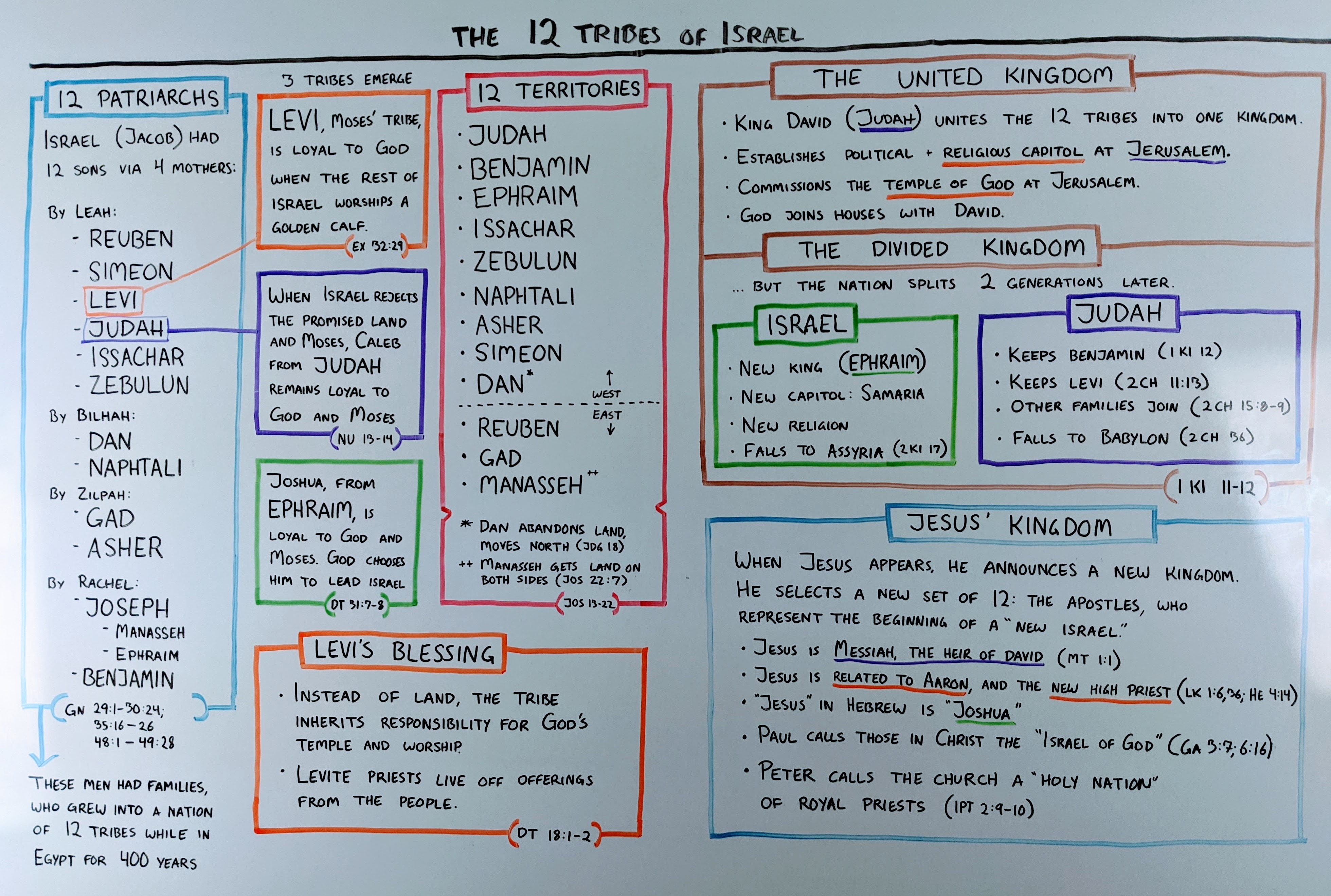The 12 Tribes of Israel in the Bible: a Quick, Illustrated Guide
Kind of like how I can assume my readers in the US immediately know what I’m talking about if I reference “D.C.,” “Houston,” or “Chicago.”
But we’re not from ancient Israel. So sometimes it helps to get a little backstory on those tribes—since we didn’t grow up hearing about them all the time.
So I’ve pulled together some info on the 12 tribes of Israel for you. Enjoy!

Contents:
- A list of the 12 (or is it 13?) tribes, with quick details
- Judah
- Reuben
- Simeon
- Levi
- Zebulun
- Issachar
- Dan
- Gad
- Asher
- Naphtali
- Ephraim
- Benjamin
- Manasseh (Wait … 13? Yep.)
- The illustrated, disturbing story of the 12 tribes
- The divided kingdom of Israel and Judah
Here we go!
A quick list of the 12 tribes of Israel
1. Judah.
The tribe of kings, and the most preeminent of the 12 tribes in the biblical narrative. Judah “prevailed over his brothers,” (1 Chronicles 5:2), and the tribe’s territory included the city of Jerusalem and the holy temple. King David was part of this tribe, and his royal line ruled in Jerusalem from around 1,000 BC until the city fell to Babylonian forces in 586 BC. Jerusalem was the capital of Israel and the capital of the Southern Kingdom after the nation divided. Jesus is of the tribe of Judah (Matthew 1:1–2). Notable tribesmen: Jesus, David, Mary, Solomon, Caleb
2. Reuben.
Descended from Jacob’s firstborn, whom Jacob said was as “uncontrolled as water” (Genesis 49:4). The tribe chose not to settle in the Promised Land, and instead asked Moses for some of the territory that they conquered east of the Jordan River. Moses agreed to this, on the condition that they assist the western tribes in conquering Canaan (Numbers 32:28–32). They did so, but they did not assist the other tribes in battle during the period of judges (Judges 5:16), and the tribe falls into scriptural obscurity.
3. Simeon.
The man Simeon (with his brother Levi) slaughtered the men of an entire city to avenge his sister (Genesis 34:25–31). The tribe’s portion of land was within the midst of Judah’s territory (Joshua 19:1); however, Simeon did not grow as rapidly as Judah and seems to have dispersed across multiple territories (1 Chronicles 4:38–43; 2 Chronicles 15:8–9). This is consistent with Jacob’s prophecy concerning Simeon and his brother Levi: “I will disperse them in Jacob, and scatter them in Israel.”
4. Levi.
The tribe of the priesthood. The tribe of Levi stood by Moses (a Levite) during the golden calf incident at Mount Sinai (Exodus 32:25–29), and later took their place as ministers to the tabernacle, and later the Temple. Levi had no tribal territory—the Lord was the tribe’s inheritance (Numbers 18:19–20)—though they did receive pasture lands for their cattle (Joshua 21). Levitical duties were extensive (read Leviticus!), but Moses gives a brief summary of their significance in his blessing for the tribe (Deuteronomy 33:8–11).
Notable tribesmen: Moses, Aaron, John the Baptist, Barnabas
5. Zebulun.
Zebulun doesn’t get very much attention in the Bible. The tribe does boast a strong, loyal fighting force during the days of the judges and King David. In fact, Zebulun had the largest presence in the army that made David king of Israel at Hebron, and they served him with “an undivided heart” (1 Chronicles 12:33).
6. Issachar.
Issachar has even less biblical presence than Zebulun, but the tribe was loyal to Deborah and Barak (Judges 5:15). They’re also remembered as “men who understood the times, with knowledge of what Israel should do” (1 Chronicles 12:32).
7. Dan.
We don’t read much about the man Dan, but we do see his tribe up to no good in the book of Judges. The tribe did not secure their original portion of land (Judges 1:34; 18:1), and instead migrated northward. In the process, they took for themselves other gods (Judges 18:14–17) and set up a new priesthood (Judges 18–20). The tribe later joins Jeroboam in idolatry when the kingdom of Israel divides (1 Kings 12:28–29). Notable tribesman: Samson
8. Gad.
Little is said of Gad, the man or the tribe. They, like Reuben, settled east of the Jordan.
9. Asher.
Jacob prophesied that Asher’s tribe would enjoy rich foods (Genesis 49:20), and the tribe went on to possess a region of eastern Galilee which is still known for its olive groves.
10. Naphtali.
Naphtali, with Zebulun, is mentioned by the prophet Isaiah in a passage we read often during Christmastime: “For a child will be born to us . . . .” This promise was given concerning the land of Galilee, specifically, the “land of Zebulun and the land of Naphtali.” You can read the whole prophecy in Isaiah 9.
11. Ephraim.
This tribe is named after Joseph’s son. Joseph received the birthright from Jacob, and instead of just one tribe, he is the ancestor of two (Manasseh is the other). After the kingdom divides, the Northern Kingdom’s capital is in Ephraim’s territory, and the prophets sometimes refer to the entire nation as “Ephraim” (Jeremiah 31:9, Hosea 5:3). Notable tribesmen: Joshua, Samuel
12. Benjamin.
This small tribe has played several important roles in Israel’s history. Benjamin stood against the rest of Israel in a national civil war (Judges 20:14–21:24). Saul, the first anointed king of Israel, was from Benjamin. The tribe was also loyal to David’s descendants when the northern tribes seceded (1 Kings 12:16–24). Notable tribesmen: King Saul, Mordecai, Paul
13. Manasseh.
This tribe descended from Joseph’s firstborn son, and uniquely settled on both sides of the Jordan River (Joshua 17:5–6). The eastern settlement is often referred to as the “half-tribe of Manasseh.”
Wait—13 tribes of Israel?
Kind of. Remember, Levi didn’t receive tribal territory like the other tribes. Also, Joseph’s sons were considered heads of their own tribes—both of which received an inheritance of land. In some lists, Joseph is counted as one of the 12 (Genesis 49; Deuteronomy 33). In others, Levi isn’t counted, and Ephraim and Manasseh are considered distinct tribes.
Here’s the math:
12 tribes – 1 (Levi) – 1 (Joseph) + 1 (Ephraim) + 1 (Manasseh) = 12 tribes
You can see the tools I used to put this list together on the original blog post. Heads up: at the time I wrote the original, I was an employee of Logos.
The story of the 12 tribes of Israel
Quick note: I made a weird mistake on this. Reuben didn’t sleep with Zilpah, he slept with Bilhah. (Which is just as messed up.) When we update this infographic, that’ll get fixed. =)

What happened to the tribes in the divided kingdom?
After Solomon’s reign, the kingdom of Israel divides. Some tribes remain loyal to David’s bloodline (the Southern Kingdom), but most tribes rebel and form their own new nation (the Northern Kingdom).
The prophet Ahijah illustrates this by tearing his cloak into 12 pieces and giving 10 pieces to Jeroboam, who would rule the Northern Kingdom. He says that one piece (Judah) will remain with Solomon’s son for the sake of God’s covenant with David (1 Ki 11:31–32).
So a little more math:
12 (Israel) — 10 (Northern Kingdom) — 1 (Judah) = 1 (who’s left?)
It turns out that Benjamin joined the tribe of Judah, and combined to form the Southern Kingdom (1 Ki 21:12). The Southern Kingdom is ruled by the house of David, who was from the tribe of Judah, so the kingdom is often just called “Judah.”
The tribe of Levi was also aligned with the South. Jeroboam set up a new priesthood to false gods in the North, and so because the temple of the Lord was in Judah, the Levites migrated there (2 Chr 11:13).
So the original divided kingdom looked like this:
| Northern Kingdom | Southern Kingdom |
|
|
However, several members of Ephraim, Manasseh, and Simeon defected to Judah when they realized that God was with the righteous King Asa (2 Chr 15:9).
So, that’s the list of tribes, and an idea of what happened to them when the kingdom split. You can read about the divided kingdom in the summary of 1 & 2 Kings.






Get the infographic
Want to download the 12 Tribes of Israel infographic? Here’s a link to the printable PDF. You can save it for future reference or send it straight to the printer.


I really enjoyed reading this! The connection is awesome! May God continue to give you the vision to touch others through the writing of his word in art and characterization.
This is an excellent and informative work. I enjoyed it very much. May Almighty God bless you always my brother.
What a great article and resource. As a layperson who studied business and government, this is such a helpful tool. I will share it with a friend in seminary. It fills in some gaps from my own reading in a study Bible and a commentary. Very helpful.
This was great information and easy to understand. This is good teaching material for Bible study night.
I would like to purchase the Twelve Tribes of Israel; an Illustrated Guide. I don’t see a purchase function in the shop for this. Can you tell me how I can obtain it?
Thanks,
Diane Meloche
Hi, Diane! Thanks for the vote of confidence—that makes me feel good. =) But unfortunately this isn’t for sale—maybe that would be a good poster for us to make in the future, though!
Super informative and completely hilarious in an oddly tragic way. It is a wonder to me daily how much he loves us earthen vessels and the depths of his mercy and compassion are just beyond my comprehension. Excellent work!
This was truly excellent, so pleased to have found this. I’m excited to go through it again and study!
Thankyou for producing this, looking forward to other work you’ve produced and are yet to produce.
Thank you so much for this wonderful guide. I have always been interested in learning about the Bible, but found all the names, dates, and places so confusing and overwhelming. Your guides, and this article in particular, were exactly what I needed all along! You have helped me to organize the information and put things in context BEFORE reading each book of the Bible. Things make so much more sense when you realize how the details fit into the big picture. I am looking forward to the release of your book. Your work is truly blessed, and has helped me strengthen my relationship with God.
Very helpful!
Solomon was not mentioned, any specific reason?
I know Solomon is mentioned in the commentary below, but it jumped from David to grandson in chart(taskmaster/finger).
While Solomon is a key figure in the biblical narrative of the kingdom of Israel, digging into his shenanigans felt a little bit distracting for an illustrated guide on the 12 tribes. ;-)
I’m so blessed to find this overview. It’d be fun to teach this to the kids in our church. May God bless you more!
I’m so glad it’s helpful, Alicia—thank you for the kind words!
Wonderful aid to understanding the Old Testament. Thank you. I shared this with my Old Testament class and one student noted that Reuben slept with Bilhah and not Zilpah. Also, we would love to be able to copy this and put in notebooks for a reference, if you are able to make it printable. Thank you.
You’re right about Bilhah—good catch!
I’d like to produce not only a printable guide, but one with better illustrations sometime this year. =)
Really enjoyed the infographic! When I try to print it however I get everything condensed to one page and thus the print is unusable. any way to get a page-formatted pdf? Thanks in advance!
Hi, Joe! Sorry about that—perhaps we’ll have a printable solution sometime this year. =)
My understanding is Moses was raised as a prince of Egypt in the royal house hold until he discovered he was an Israelite, he was never a shepherd
“Now Moses was tending the flock of Jethro his father-in-law, the priest of Midian, and he led the flock to the far side of the wilderness and came to Horeb, the mountain of God.” (Exodus 3:1)
Thank you! I was blessed reading this.
This is very good. Thank you and especially for allowing others to use it. I am currently doing my own research of the 12 tribes and putting together my own study and I am definitely use this as a reference.
Thanks for the kind words, Gio!
My church is going through the minor prophets this summer. I would love to see something like this either put in the study guide or up on the walls to give our people a visual and a timeframe to work from. Are there stipulations on how we can use this infographic. We would of course give you credit for your great work!
No stipulations—enjoy using this for ministry if it’s helpful. =)
I teach Mormons. Can I put this in my video?
Sure!
incredible research work! You are blessed to give your time!
Also, you know how there are many who claim that everyone from the Northern Kingdom were either completely wiped out or intermarried with foreigners to the point of losing their Hebrew ethnicity? I don’t think that’s true at all.
As you said, people from Joseph & Simeon defected to Judah. And we can’t forget prophetess Anna from the tribe of Asher, in the New Testament. The New Testament took place 722 YEARS after the Assyrian exile, and yet there was at least one surviving descendant of the Northern Kingdom.
I had known that prior to the divide there were about 48 Levite Cities scattered through each tribe, with a total of 13 in the territorites of Judah & Benjamin. I didn’t know all of them migrated to Judah after the split. That means more Levites made it through the exiles than I previously thought :-). And it makes me very happy to know that many from the 2 tribes of Joseph defected to Judah as well.
Since Joseph was extremely faithful to God in Egypt, despite all the abuses he was put through, (and considering how the great Joshua was from Ephraim) I was very heartbroken when I discovered that his 2 tribes fell into idolatry, and that most didn’t return from the exile.
So finding out that many of them remained faithful, and that many of them escaped the Assyrians is a relief.
thanks . Its nice. However , some notable men were missed . Mannasseh produced gideon (judges 6:15) . But who produced elijah ?
thanks… this was a great overview! again Thank You Jeffery~